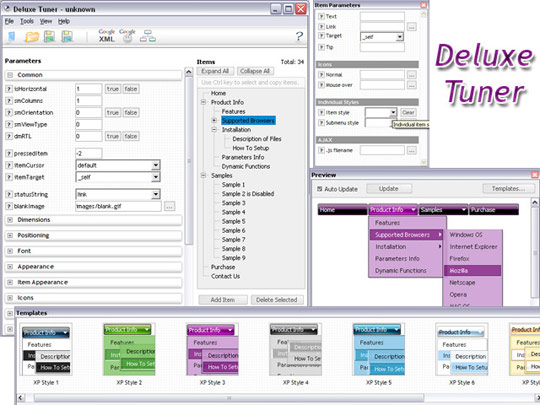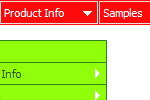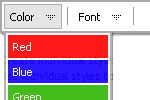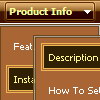Recent Questions
Q: As a part-time webdeveloper I have gotten very interested in your product. I really appreciate a number of things
- it's very flexible
- it's very easy to work with
- examples nicely show the capabilities
But I have a couple of questions:
- When opening a menu, there is an option for keeping the menu-item that has been pressed hightlighed (so that the user can see what he/she pressed). Is it possible, programmatically, to decide when this highlighting should be removed? The scenario is that, when a menu-item is clicked the used might browse for a couple of pages within the context defined by the menu-item, but when the user leaves, the menu-item should no longer be highlighted. I will (programmatically) decide the context, but is it possible for me to interact with the menu, and for example decide explicitly which menu should be highlighted?
- Our design department would like the menu containing the elements: "Skovdrift, Juletreer, Skovrejsning, etc". Please notice that "Brende" is supposed to show a menu item that is hightlighted. Is is possible to create this menu such that it is dynamic and each item is text-based (and not based on two pictures for each menu-entry: hightlighted and not)? I've been wondering how to solve this problem, but I cannot figure out a solution. The problem that I is stuck at, is how organise this speciel "frame" around each menu-element. Something that be partly accomplished using "arrowImageMain", but that does not bring me all the way. Please notice that the menu-items might not have any sub-menu.
A: I suppose that you're saying about
var pressedItem=-2;
Defines an item that will appear in the highlighted state
(-2 - normal mode, -1 - toggle mode is active, but highlighted item not defined, 0,1,2,3,... - # of pressed item including separators)
This parameter will not approach you.
You should set a pressed item using Javascript API:
function dm_ext_setPressedItem (menuInd, submenuInd, itemInd, recursion)
Sets a current pressed item.
menuInd - index of a menu on a page, >= 0.
submenuInd - index of a submenu, >= 0.
itemInd - index of an item, >=0.
recursion = true/false - highlight parent items.
But notice, to use dm_ext_setPressedItem() you should know ID of selected item and subitem.
You can't get this ID after you reload your page. That is why you should write your own code on PHP.
Q: In IE 6.0 and Firefox 1.5.0.4, the dropdown submenus are not visible and it does not float in firefox (floats in IE but no submenus) whereas in Opera 8.53 and Opera 9 it works fully.
A: Now you have two entries of dmenu.js file on your site in the <head> and <body> tags.
You must have only one entry of dmenu.js file.
You should write so:
...
<body>
<script type="text/javascript"> var dmWorkPath = "http://www.gaurangapada.org/data.files/";</script>
<script type="text/javascript" src="http://www.gaurangapada.org/data.files/dmenu.js"></script>
</body>
Please, delete the same code from the tag.
Now you have:
var transparency="0";
That is why you can't see your subitems.
Please, write, for example, so:
var transparency="80";
Q: I am trying to use the following horizontal tabs menu:
http://deluxe-tabs.com/file/templates/deluxe-tabs-style-3.html
My problem is that the bitebackimage is not showing as you can see in the example below.
All the left and right side images appear, but not the repeating button background. All the images are in the same directory and have the same URL to point to them.
Any ideas on what the problem might be?
A: The reason is in your styles. Now you have in style.css file:
TABLE {
FONT-SIZE: 10pt; BACKGROUND-REPEAT: no-repeat; FONT-FAMILY: Arial,Helvetica,sans-serif
}
TR {
FONT-SIZE: 10pt; BACKGROUND-REPEAT: no-repeat; FONT-FAMILY: Arial,Helvetica,sans-serif
}
TD {
FONT-SIZE: 10pt; BACKGROUND-REPEAT: no-repeat; FONT-FAMILY: Arial,Helvetica,sans-serif
}
You should write:
TABLE {
FONT-SIZE: 10pt; FONT-FAMILY: Arial,Helvetica,sans-serif
}
TR {
FONT-SIZE: 10pt; FONT-FAMILY: Arial,Helvetica,sans-serif
}
TD {
FONT-SIZE: 10pt; FONT-FAMILY: Arial,Helvetica,sans-serif
}
Q: I have tried to use the Deluxe tuner menu in one of the websites I am trying to create however, the menu gives an error. I have created the menu multiple times but everytime it comes up with the same error. I have attached the entire web page file with this mail. Can you please go through this and help me fix the errors.
A: Now you have var itemBorderWidth=""; var menuBorderWidth="";
It is not correct. You should set values for these parameters.
var menuBorderWidth="0"; var itemBorderWidth="0";










